Setting Each Exposure Mode While pressing MODE button, rotate Main-Command Dial. The exposure mode changes as in the following sequence:
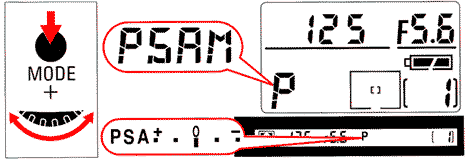 |
For users of lenses that have no CPU, or accessories such as bellows attachment or extension rings - Use Aperture-Priority Auto or Manual exposure mode. Programmed Auto or Shutter-Priority Auto exposure mode automatically shifts to Aperture-Priority Auto exposure mode with |
 |
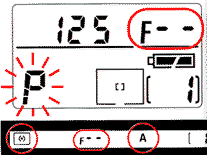 |
NOTE: If 3D Color Matrix Metering is set on the camera, metering system is also automatically shifted to Center-Weighted. |
Shooting in Each Exposure Mode
Operation in Shutter Priority Auto Exposure Mode: While pressing MODE button, rotate Main-Command Dial until
* This operation can be performed only with lenses having a built-in CPU.
* If meter and LCD readout have turned off, turn on again by lightly pressing shutter release button.
* If "bulb" is set on the camera, selecting the Shutter Priority Auto mode will cause
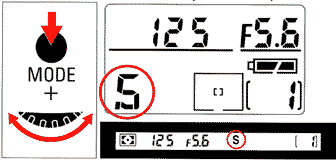 |
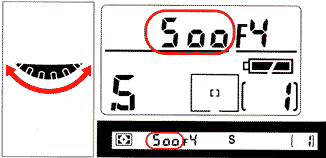 |
Remove finger from MODE
button, and rotate Main Command Dial to select desired shutter speed. Shutter speed
indications change in 1/3 steps between 30 sec and 1/8000 sec., and flash sync speed
of 1/250 sec. ( |
The direction that the Main-Command Dial is turned to increase/decrease shutter speed can be changed using Custom Setting #6. |
3. Look inside viewfinder, compose
and lightly press shutter release button. Confirm the automatically set aperture
value.
4.To take the picture, fully depress shutter release button
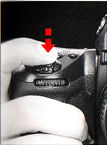 |
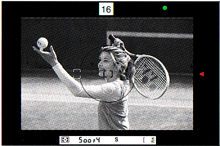 |
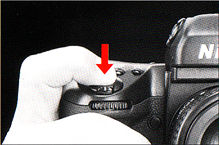 |
Note: Lock function operates only with lenses having a CPU, when the lens is set and locked at its minimum aperture. |
![]() The selected shutter speed can be locked using
the lock function to avoid accidental changes of settings. To lock the shutter speed,
rotate the Main-Command Dial while pressing the
The selected shutter speed can be locked using
the lock function to avoid accidental changes of settings. To lock the shutter speed,
rotate the Main-Command Dial while pressing the ![]() button
button ![]() . appears in the top LCD panel and
. appears in the top LCD panel and ![]() in the viewfinder above the shutter
speed indications. To release the lock, rotate Main-Command Dial while pressing the
in the viewfinder above the shutter
speed indications. To release the lock, rotate Main-Command Dial while pressing the
![]() button
again, or select another exposure mode.
button
again, or select another exposure mode.![]() and
and ![]() disappear.
disappear.
 |
 |
|
| If |
if |
 |
If |
Operation in Aperture-Priority Auto Exposure Mode 1. While pressing MODE button, rotate Main-Command Dial until
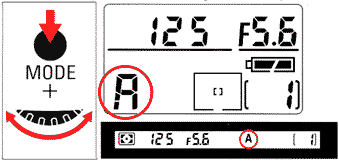 |
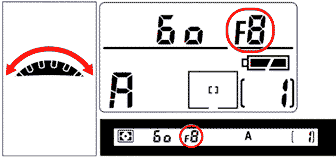 |
Note: Lock function operates only with lenses having a CPU, when the lens is set and locked at its minimum aperture. |
2. Remove finger from
MODE button, and rotate Sub-Command Dial to select desired aperture. (Make
sure to set lens to its minimum aperture position.) Aperture set is indicated in
the top LCD panel and viewfinder. Aperture Indication changes in 1/3 steps between
lens' maximum and minimum apertures. (Available apertures limited to those of lens
in use.)
* Aperture
can also be set by rotating the lens aperture ring. In this case, ![]() blinks in the viewfinder and top
LCD panel, and aperture can be confirmed only through the aperture direct readout
In the viewfinder. * To select minimum aperture with the lens aperture ring, make
sure to also set aperture to minimum with Sub-Command Dial; the reason being that
when the lens' aperture ring is set to its minimum, aperture set with Sub-Command
Dial will be effective.
If meter
and LCD readout have turned off, turn on again by lightly pressing shutter release
button.
blinks in the viewfinder and top
LCD panel, and aperture can be confirmed only through the aperture direct readout
In the viewfinder. * To select minimum aperture with the lens aperture ring, make
sure to also set aperture to minimum with Sub-Command Dial; the reason being that
when the lens' aperture ring is set to its minimum, aperture set with Sub-Command
Dial will be effective.
If meter
and LCD readout have turned off, turn on again by lightly pressing shutter release
button.
|
|
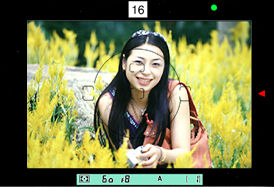 |
|
3.Look inside viewfinder, compose and lightly press shutter release button. Confirm automatically set shutter speed. |
Aperture can be set NOT to change by rotating Sub-Command Dial using Custom Setting #22. Set aperture by rotating the lens' aperture ring in this case. |
4.Fully depress shutter release button to take picture.
 |
 |
|
| If |
If |
Operation in Manual Exposure Mode 1. While pressing MODE button, rotate Main-Command Dial until
2. Remove finger from MODE button, set shutter speed by rotating the Main-Command Dial.
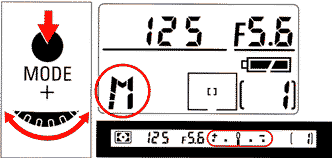 |
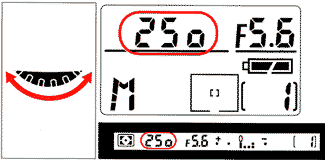 |
Shutter speed can be set in 1/3 steps. In Manual exposure mode, you can set shutter speed to |
Slowest shutter speed can be changed from 30 sec. to as much as 30 minutes using Custom Setting #19. |
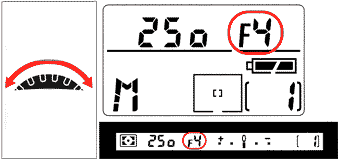 |
3. Set aperture by rotating the Sub-Command Dial. (Lens' aperture set to its minimum position.) Aperture can be set in 1/3 steps between lens' maximum minimum apertures. Note: Aperture can also be set by rotating the lens aperture ring. In this case, |
Aperture can be set not to change by rotating Sub-Command Dial using Custom Setting #22. Set aperture by rotating the lens' aperture ring in this case. |
|
|
4. Look into viewfinder, compose shot and lightly press shutter release button. Adjust aperture and/or shutter speed until the electronic analog exposure display shows "0" or your desired amount. 4.Fully depress shutter release button to take picture. |
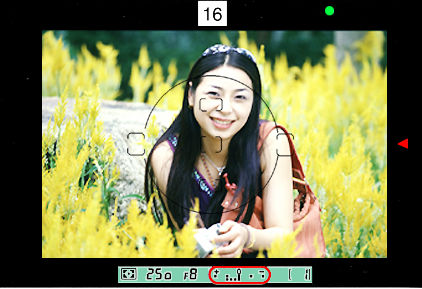 |
|
||||||
|
|
Note: With lenses having no CPU, |
| previous | NEXT | 6/18 Flexi-Program, AE Lock, Exposure Compensation etc.
| Back to Index Page |
Instruction Manual for Nikon F5
|
Back | Main Index Page - Nikon F5
Professional SLR camera
The Camera - Background,
Issues & Summary
Basic
Features | Focusing | Metering Systems | Exposure Control | Reliability Issues | Nikkor lens Compatibility
Prisms/Finders - Index page
- 2 parts
Film Backs: Index
Page - 1 parts
Focusing Screens - Index
Page - 1 part
Flash System - Index
Page
- 3 parts
System Accessories: | Power Sources | Cases | Remote
Control | Miscellaneous
Macro
Photography
- Related info on Micro-Nikkor lenses
Technical Specification for Nikon F5
Main
Reference Map
/ Nomenclature
Resource Centre:
Instruction Manuals
Nikon
F5 Camera Body
- 18
parts
MF-28
Multi-Function Back
HTML - 8
parts
PC
Links - Photo Secretary
- 2
parts
AF-TTL Speedlights:
SB-28 / SB28DX | SB29(s) info | SB30 | SB50DX | SB80DX | SB600 info | SB800
Variants: F5 50th Anniversary Model | Nikon/Kodak DCS-620 | DCS-720 Digital Still SLR camera
| Nikon F | Nikon F2 | Nikon F3 | Nikon F4 | Nikon F5 | Nikon F6 | Nikkormat / Nikomat | Nikon FM | Nikon FE/ FA | Nikon EM/FG/FG20 | Nikon Digital SLRs | Nikon - Other models |
The Eyes of Nikon:-
Nikon Auto Focus Nikkor lenses:- Main
Index Page
Nikon Manual Focus Nikkor lenses:- Fisheye-Nikkor Lenses - Circular | Full Frame |
Ultrawides Lenses - 13mm15mm18mm20mm | Wideangle Lenses - 24mm28mm35mm | Standard Lenses - 45mm 50mm 58mm | Telephoto
Lenses - 85mm105mm135mm180mm & 200mm | Super-Telephoto Lenses - 300mm 400mm 500mm 600mm 800mm 1200mm |
 Index Page |
Special
Application lenses: Micro-Nikkor Lenses - 50mm~55mm -60mm 85mm -105mm 200mm Micro-Zoom 70-180mm Perspective Control (PC) - 28mm 35mm PC-Micro 85mm Dedicated Lenses for Nikon F3AF: AF 80mm f/2.8 | AF 200mm f/3.5 EDIF Depth of Field Control (DC): 105mm 135mm Medical Nikkor: 120mm 200mm Reflex-Nikkor Lenses - 500mm 1000mm 2000mm Others: Noct Nikkor | OP-Nikkor | UV Nikkor 55mm 105mm | Focusing Units | Bellows-Nikkor 105mm 135mm Nikon Series E Lenses: 28mm35mm50mm100mm135mm | E-Series Zoom lenses: 36~72mm75~150mm70~210mm |
MF Zoom-Nikkor Lenses: 25~50mm | 28~45mm | 28~50mm | 28~85mm | 35~70mm | 36~72mm E | 35~85mm | 35~105mm | 35~135mm | 35~200mm | 43~86mm | 50~135mm | 50~300mm | 70~210mm E | 75~150mm E | 80~200mm | 85~250mm | 100~300mm | 180~600mm | 200~400mm | 200~600mm | 360~1200mm | 1200~1700mm
Tele-Converters: TC-1 | TC-2 | TC-200 | TC-201 | TC-300 | TC-301 | TC-14 | TC-14A | TC-14B | TC-14C | TC-14E | TC-16 | TC-16A | TC-20E
Recommended links to understand more technical details
related to the Nikkor F-mount and production Serial Number:
http://rick_oleson.tripod.com/index-153.html by: my
friend, Rick Oleson
http://www.zi.ku.dk/personal/lhhansen/photo/fmount.htm by: Hansen,
Lars Holst
http://www.mir.com.my/rb/photography/hardwares/nikonfmount/lens2.htm
http://www.photosynthesis.co.nz/nikon/serialno.html
| Back | Index Page of Digital
Nikon SLR cameras
|
Back | Main Index Page of Pictorial
History of Nikon SLR cameras
![]()
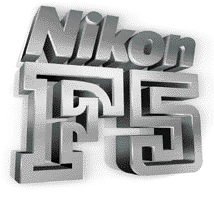 |
| Message Board | for Nikon F5 Series SLR model(s) | |
HOME - Photography in Malaysia |
![]()
A resource dedicated to my kids, Alvin Foo & Esther Foo- one day,
BOTH might need to use all these information for his/her Nikon F5A camera.
Volunteered Maintainer(s) for the Nikon F5 Message Board: Tony Davies-Patrick, UK; Rick Oleson, US; Koh Kho King, Malaysia.
Credit: Mr. Chuck Hester, US for his text re-editing skill for this site; Our staff, HowKiat® who created the 3D-Nikon F5 logo. Mr. Lew Chee Wai of YL camera for lending his F5 for me to take some shots appeared in this site. All those nice folks who have contributed their images, in particular Mr. Mike Long, Edwin leong, Palmi Einarsson, Sergio Pessolano, Fred Kamphues, Harry Eggens, Curtis Forrester, Nick (Natures Moments), Sandra Bartocha; fellow countrymen, Vincent Thian, Koh Kho King, Philip Chong, CY Leow etc. and contributions from a few nice folks from Photo Malaysia Forum. Disclaimers & acknowledgments: Certain content and images appeared in this site were either scanned from official marketing leaflets, brochures published by Nikon and/or contribution from surfers who claimed originality of their own work for public publishing in this website, where majority of the extracted information are used basing on educational merits. The creator of this site will not be responsible for any discrepancies that may arise from any possible dispute except rectifying them after verification from respective source. Neither Nikon or its associates has granted any permission(s) in using their public information nor has any interest in the creation of this site. "Nikon", "Nikkormat", "Nippon Kokagu KK" "Silent Wave", "Focus Tracking Lock-on", "Nikkor" & other applicable technical/business terms are registered trade name(s) of Nikon Corporation Inc., Japan. Site made with an Apple G5 IMac.
